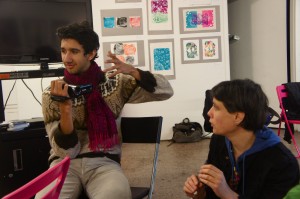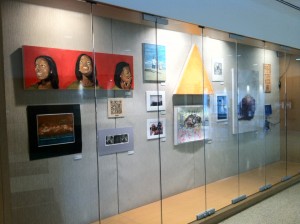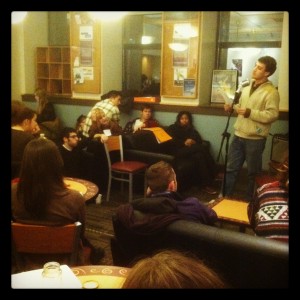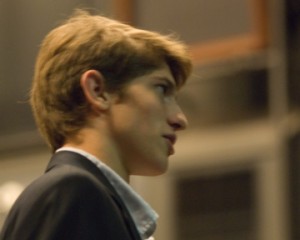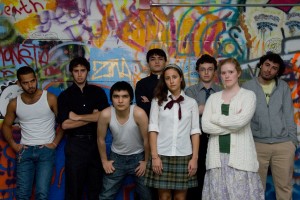Matthew Chilton ’16 previews the free concert “Sonic Introductions: Graduate Student Composers at Wesleyan,” which will be held on Thursday, October 17, 2013 at 8pm in CFA Hall.
Wesleyan’s musical diversity is one of the most celebrated facets of its student life. Float between conversations as the weekend begins and you’ll inevitably hear talk of the next great show at Eclectic, Buddhist House, or another notable space on campus. But listen a little closer, and you’ll hear a quieter buzz—tune in—it sounds a little like a homemade oscillator, or a circuit-bent stylophone, perhaps a clarinetist falling down a flight of stairs. You really don’t know what it is, but your intellectual and musical curiosity implore you to check it out—after all, that’s why you’re here in this narrative, right?

Bring your curiosity and sharpened ears to the CFA Hall tonight at 8pm for “Sonic Introductions,” a concert dedicated to new works of Wesleyan music graduate students. This is a special type of concert that often falls under the radar for undergrads, and certainly not one to miss. Fortunately, that weird sound got your attention earlier. Each of the artists who will present their work tonight embodies part of what makes Wesleyan such a vibrant musical environment. Each composer brings a distinct background and developed musical persona, ensuring that no two pieces will sound alike.
The musicians’ approach to composition is not limited to the standard dots on paper. Peter Blasser and Daniel Fishkin, both instrument builders, liken their methods of composing to building new instruments. Mr. Blasser focuses on building a core composition, and then transforming it as if manipulating the knobs on a synthesizer. He describes his piece as something of a “product demonstration,” challenging the common performer-audience dynamic by focusing on the principles of his instrument rather than codified notions of form and intention.
Mr. Fishkin builds daxophones, bowed, amplified wooden tongues whose sounds are oddly human grunts and moans, as well as varieties of electronic music. He challenges notions of traditional composition by eschewing the pen-and-paper methods of conventional music for something more personal and intuitive. His composition is intimately bound up in his experience with tinnitus, the hallucinatory hearing disorder. In order to cope with the incessant whining in his ears, his response is to “compose himself.”
Nathan Friedman began his musical life as a classical clarinetist, before transitioning his playing into the worlds of experimental improvisation, contemporary chamber music, and klezmer. His work searches for a sound that is non-idiomatic, well beyond the reaches of a single style. He seeks to make the complex sound simple, while denying his listener a definite stylistic point of reference. The piece he premieres tonight is entitled Four Domestics for voice and piano, on texts by the Canadian socialist poet F.R. Scott. It will be sung by Stephanie Trotter, a wonderful vocalist and frequent collaborator.
Like Mr. Friedman, soprano saxophonist Jasmine Lovell-Smith is striving for a music that renders stylistic boundaries irrelevant. However, she takes a different approach, focusing on strong melodies and naturally unfolding harmonies that invite the listener to take refuge in her soundworld. Her jazz background informs her writing and improvisations, yet her composition relies on the ear rather than the analytical mind. Tonight, she premieres a setting of a poem by e.e. cummings for an ensemble of voice, clarinet, and guitar.
Violinist Dina Maccabee comes from a varied stylistic background of folk, pop, classical, and improvised music. She cites the chameleon-like versatility and easy portability of her instrument as her portal into many musical worlds. Her compositions for this concert revolve around the melodic and timbral interactions between her voice and violin, refined into short pop songs. Taken out of their original theatrical context, Ms. Maccabee uses this new setting to explore the intentionality behind her work.
Gabriel Kastelle, the other violinist on the program, eschews his instrument of choice to direct one of Wesleyan’s finest student vocal ensembles – the Mixolydians. Mr. Kastelle’s background has deep roots in everything from folk fiddle music to the avant-garde. His piece this evening is rooted in the American art of shape note singing, a simple and easy-to-read notation system for vocal ensembles that developed at the beginning of the 19th century in New England. Mr. Kastelle doesn’t complicate this accessible language, working with the interesting sounds possible within the scope of one key. His brief piece utilizes what he calls a “narrative form,” avoiding overly linear developments while letting motifs elaborate and unfold.
Also presenting works tonight are Hallie Blejewski, Sam Dickey, Sean Sonderegger, Cristohper Ramos Flores, and Jason Brogan, all powerful composers with backgrounds and stylistic aims as varied as those mentioned above. “Sonic Introductions” promises to be an unforgettable showcase of some of the most creative and groundbreaking work in music happening at Wesleyan this year. I’m excited just writing about it.




